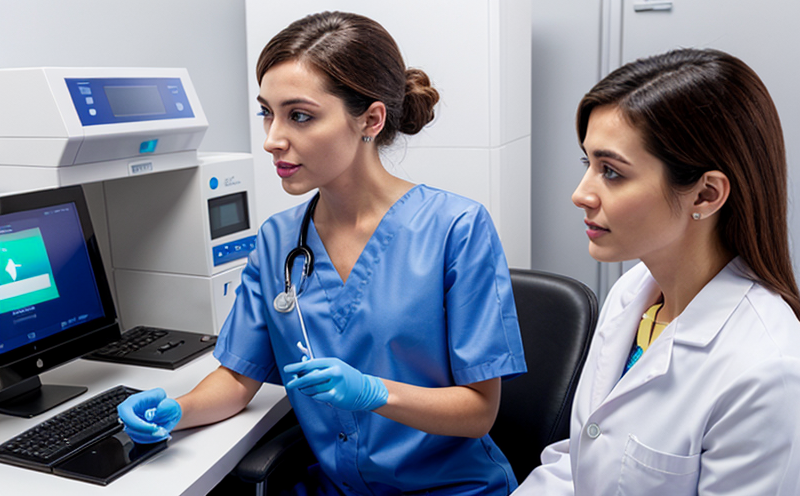RT-PCR Detection of Norovirus in Seafood
The rapid and accurate detection of noroviruses in seafood is crucial to ensure public health safety. Noroviruses are a leading cause of non-bacterial gastroenteritis worldwide, affecting millions annually. They can be easily transmitted through contaminated food or water, particularly shellfish like oysters, clams, and mussels. The use of real-time reverse transcription polymerase chain reaction (RT-PCR) is the gold standard method for identifying noroviruses due to its high sensitivity and specificity.
Our service involves a multi-step process that begins with the collection of seafood samples from various sources. Specimens are then prepared according to strict protocols, ensuring they meet the stringent requirements set by international standards such as ISO 21576-1 for shellfish quality assurance. The subsequent steps include RNA extraction and reverse transcription into cDNA using a validated protocol.
The RT-PCR reaction is performed on an automated thermocycler capable of precise temperature control, crucial for maintaining the integrity of the amplification process. Primers specific to norovirus are used, targeting conserved regions ensuring broad detection capabilities across different genotypes. The presence of target sequences is detected by fluorescence-based probes that emit a signal upon hybridization and amplification.
Our laboratory ensures accurate reporting through rigorous quality control measures. This includes internal controls, external proficiency testing participation (e.g., proficiency test from AOAC), and regular calibration checks for all instruments involved in the process. The results are reported within 24 hours of receiving a valid specimen, adhering to strict deadlines as mandated by public health authorities.
Given the potential for widespread outbreaks linked to contaminated seafood, this service plays an integral role in maintaining food safety standards and protecting consumers from illness. By providing timely insights into norovirus presence in seafood, we contribute significantly to global food safety initiatives.
| Sample Type | Collection Method | Preparation Time |
|---|---|---|
| Shellfish | Manual harvesting or aquaculture sampling | 1-2 hours |
| Molluscs | Plankton net or shellfish rake | 0.5-1 hour |
| Crustaceans | Prawn traps or shrimp boats | 2-3 hours |
The table above outlines the typical collection methods and preparation times for different types of seafood, emphasizing the importance of efficient sample handling.
Quality and Reliability Assurance
- We adhere to strict ISO standards ensuring consistent results across all tests.
- Participation in external proficiency testing programs further validates our methods.
The reliability of our RT-PCR detection service is underpinned by several key practices. Firstly, we utilize only the latest technology available, including advanced thermocyclers and high-quality reagents. Secondly, our team undergoes continuous training to stay abreast of any developments in molecular biology techniques.
To ensure quality control, every batch of samples undergoes internal validation checks using positive and negative controls. External proficiency testing is also conducted regularly against established benchmarks. Our commitment to accuracy extends to maintaining a clean and controlled environment within the laboratory, free from cross-contamination risks.
Environmental and Sustainability Contributions
In our pursuit of excellence in genetic and molecular diagnostic testing, we recognize the importance of environmental stewardship. By offering this service, we contribute positively to both public health and sustainability efforts. Our rigorous protocols minimize waste generation while ensuring efficient resource utilization.
The use of advanced technology like RT-PCR allows for more precise and targeted analyses, reducing unnecessary chemical usage and laboratory space requirements. Additionally, our involvement in food safety initiatives helps prevent outbreaks that could otherwise lead to significant environmental impacts due to mass recalls or discarded contaminated products.
Use Cases and Application Examples
- Preventive measures for large-scale events where seafood consumption is prevalent.
- Monitoring of aquaculture facilities to ensure compliance with international food safety standards.
The application of our RT-PCR detection service spans various scenarios, primarily aimed at safeguarding public health. For instance, it can be utilized during major conferences or sporting events attended by numerous individuals. By detecting noroviruses early in these settings, we help mitigate the risk of widespread illness.
Another significant use case involves monitoring of aquaculture operations to ensure they adhere to stringent food safety regulations set forth by bodies like the FDA and WHO. This proactive approach ensures continuous compliance without disrupting business activities.
| Use Case | Description |
|---|---|
| Outbreak Investigation | Detecting noroviruses during suspected outbreaks to identify the source and prevent further spread. |
| New Product Launch | Evaluating newly processed seafood products for potential contamination before market release. |
| Retailer Compliance | Testing shipments received from suppliers to ensure they meet quality standards. |





